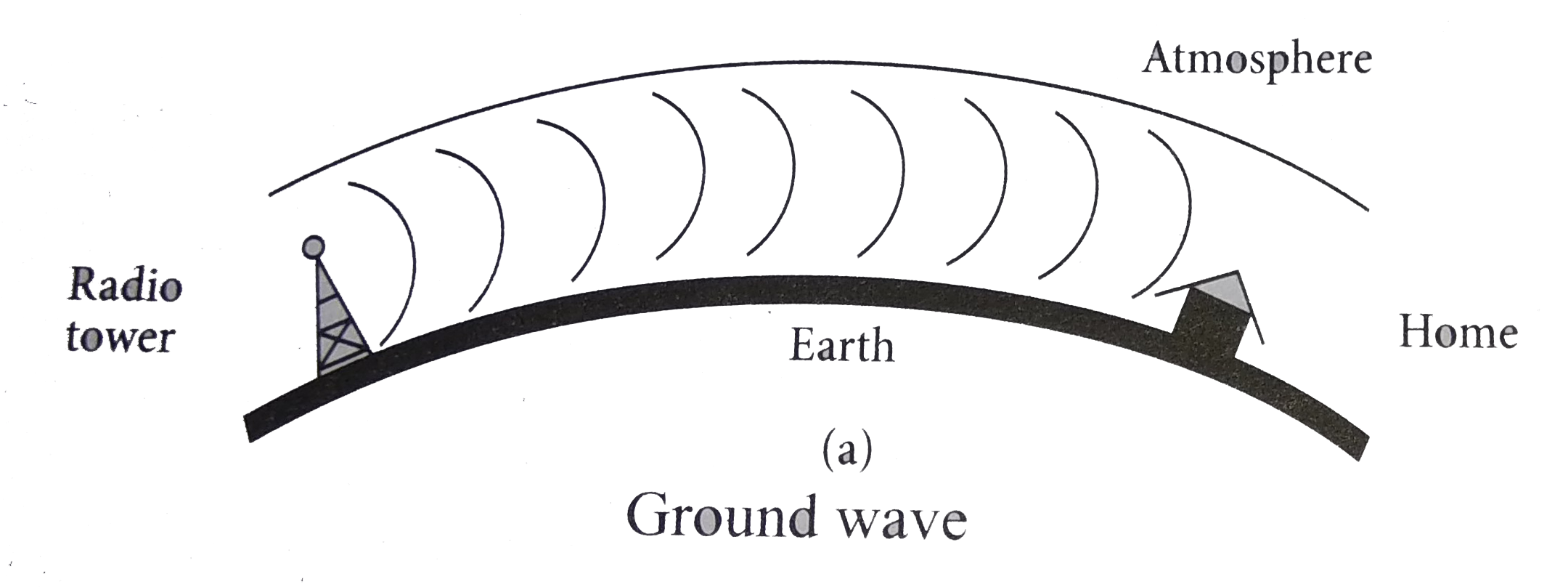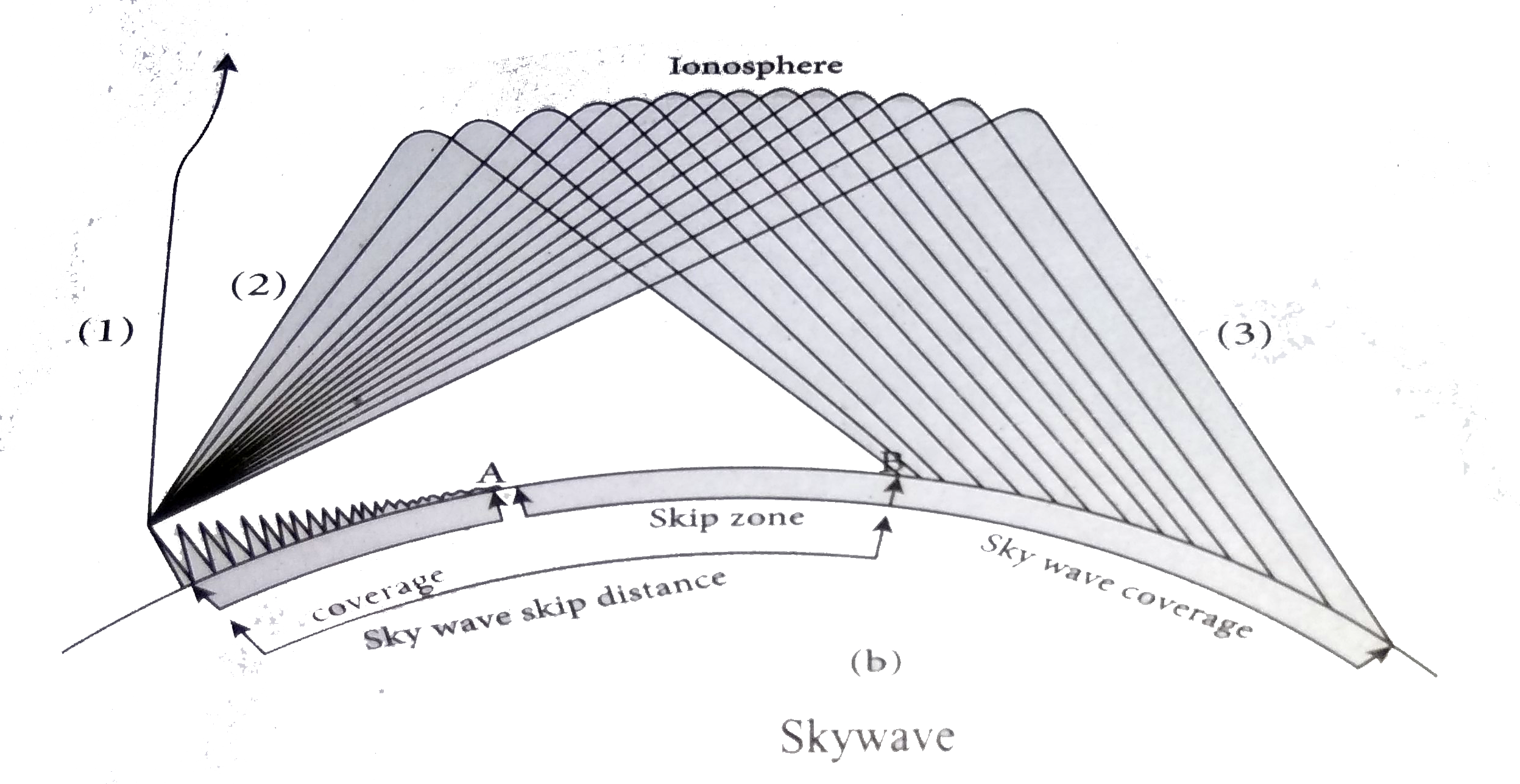Explain the three modes of propagation of electromagnetic waves through space.Solution in Tamil
Propagation of electromagnetic waves:
The electromagnetic wave transmitted by the transmitter travels in three different modes to reach the receiver according to its frequency range:
(i) Ground wave propagation (or) surface wave propagation (nearly 2 kHz to 2 MHz)
(ii) Sky wave propagation (or) ionospheric propagation (nearly 3 MHz to 30 MHz)
(iii) Space wave propagation (nearly 30 MHz to 400 GHz)
(i) Ground wave propagation
If the electromagnetic waves transmitted by the transmitter glide over the surface of the earth to reach the receiver, then the propagation is called ground wave propagation. The corresponding waves are called ground waves or surface waves.
Both transmitting and receiving antennas must be close to the earth. The size of the antenna plays a major role in deciding the efficiency of the radiation of signals. During transmission, the electrical signals are attenuated over a distance. Some reasons for attenuation are as follows:

* Increasing distance: The attenuation of the signal depends on (i) power of the transmitter (ii) frequency of the transmitter, and (iii) condition of the earth surface.
* Absorption of energy by the Earth: When the transmitted signal in the form of EM wave is in contact with the Earth, it induces charges in the Earth and constitutes a current. Due to this, the earth behaves like a leaky capacitor which leads to the attenuation of the wave.
* Tilting of the wave: As the wave progresses, the wavefront starts gradually tilting according to the curvature of the Earth. This increase in the tilt decreases the electric field strength of the wave. Finally, at some distance, the surface wave dies out due to energy loss.
The frequency of the ground waves is mostly less than 2 MHz as high frequency waves undergo more absorption of energy at the earth.s atmosphere. The medium wave signals received during the day time use surface wave propagation. It is mainly used in local broadcasting, radio navigation, for ship-to-ship, ship-to-shore communication and mobile communication.
(ii) Sky Wave Propagation:
The mode of propagation in which the electromagnetic waves radiated from an antenna, directed upwards at large angles gets reflected by the ionosphere back to carth is called sky wave propagation or ionospheric propagation. The corresponding waves are called sky waves.
The frequency range of EM waves in this mode of propagation is 3 to 30 MHZ. EM waves of frequency more than 30 MHz can easily penetrate through the ionosphere and does not undergo reflection. It is used for short wave broadcast services. Medium and high frequencies are for long-distance radio communication. Extremely long distance communication is also possible as the radio waves can undergo multiple reflections between the earth and the ionosphere. A single reflection helps the radio waves to travel a distance of approximately 4000 km.

Ionosphere acts as a reflecting surface. It is at a distance of approximately 50 km and spreads up to 400 km above the Earth surface. Due to the absorption of ultraviolet rays, cosmic ray, and other high energy radiations like a, B rays from sun, the air molecules in the ionosphere get ionized. This produces charged ions and these ions provide a reflecting medium for the reflection of radio waves or communication waves back to earth within the permitted frequency range. The phenomenon of bending the radio waves back to earth is nothing but the total internal reflection.
(iii) Space wave propagation:
The process of sending and receiving information signal through space is called Spa wave communication. The electromagnetic waves of very high frequencies above MHz are called as space waves. These waves travel in a straight line from the transmitter to the receiver. Hence, it is used for a line of sight communication (LOS).

Space wave For high frequencies, the transmission towers must be high enough so that the transmitted and received signals (direct waves) will not encounter the curvature of the earth and hence travel with less attenuation and loss of signal strength. Certain waves reach the receiver after getting reflected from the ground.
Topper's Solved these Questions
- BOOK - FULL MARKSCHAPTER - SAMPLE PAPER-05 ( SOLVED ) EXERCISE - PART-III9videos
SAMPLE PAPER-05 ( SOLVED )
- BOOK - FULL MARKSCHAPTER - SAMPLE PAPER 9EXERCISE - PART-IV10videos
SAMPLE PAPER 9
- BOOK - FULL MARKSCHAPTER - SAMPLE PAPER-07 (SOLVED )EXERCISE - (PART - IV)(Answer all the questions.)10videos
SAMPLE PAPER-07 (SOLVED )
Similar Questions
Give the relation between electric field and electric potential .
02:52View SolutionHow do we determine the electric field due to a continuous charge distribution ? Explain. Electric field due to continous charge distribution
01:28View SolutionCalculate the electric field due to a dipole on its equatorial plane. (OR) Electric field due to an electric dipole at a point on the equatorial plane
View SolutionDistinguish between Sky wave and Space wave modes of propagation in a communication system.
09:15View SolutionElectromagnetic waves propagate through space in ____
08:50View SolutionExplain the three modes of propagation of electromagnetic waves through space.
06:38View SolutionExplain the three modes of propagation of electromagnetic waves through space. Propagation of electromagnetic waves:
06:18View SolutionExplain the three modes of propagation of electromagnetic waves through space.
02:59View SolutionDistinguish between Sky wave and Space wave modes of propagation in a communication system.
03:14View SolutionDistinguish between Sky wave and Space wave modes of propagation in a communication system.
02:06View SolutionWrite the range of frequencies of electromagnetic waves which propagate through sky wave mode.
View SolutionExplain space wave propagation of radiowaves.
01:42View SolutionExplain space wave propagation.
02:23View SolutionThe electromagnetic waves that propagate in space is :
04:05View SolutionTelevision broadcast is done by space wave mode of propagation.What is the difference between sky wave and space wave modes of propagation?
03:23View Solution

